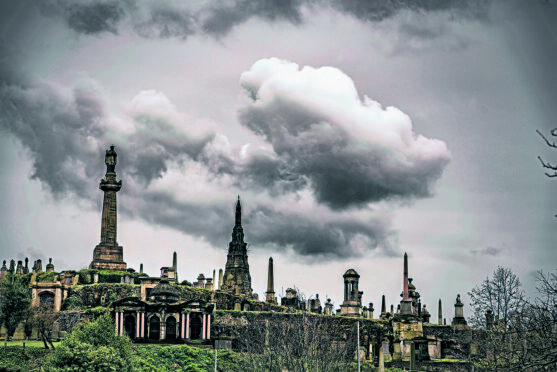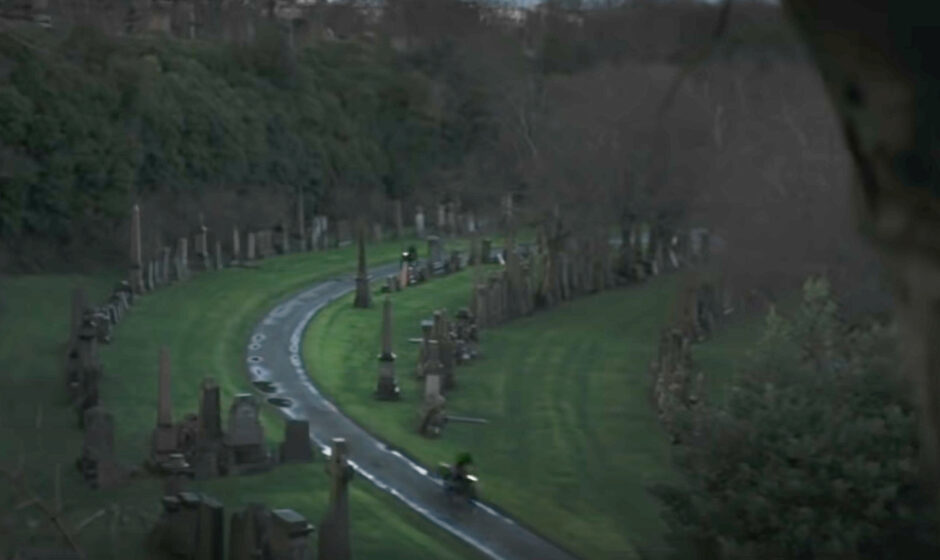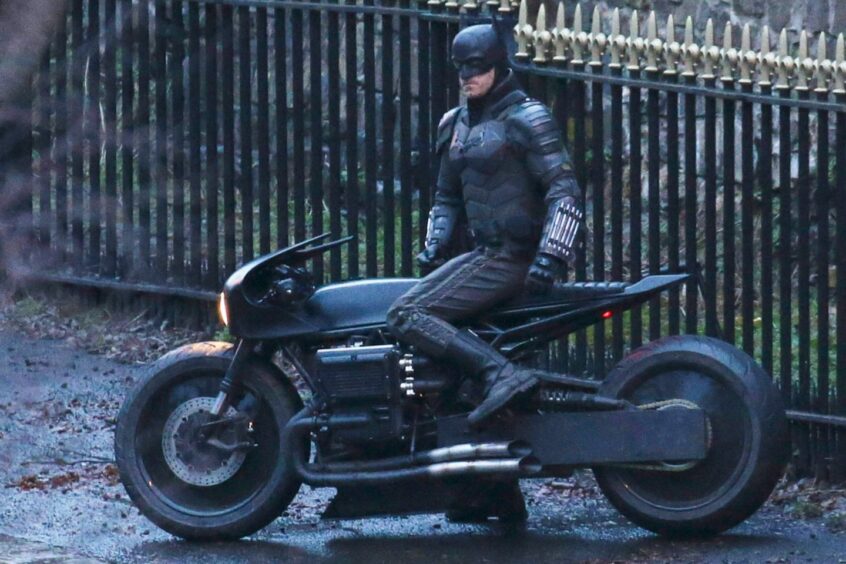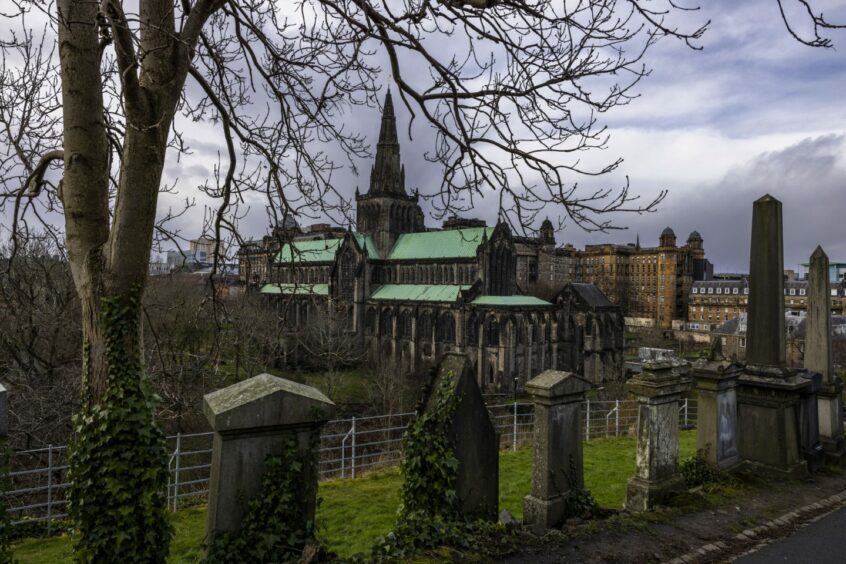
“Welcome,” says Annette, “to this city of the dead. Please take your last breath in this world and follow me.”
Annette Mullen is a volunteer guide at the Glasgow Necropolis, the first and most magnificent of the city’s Victorian garden cemeteries. There are 20 of us on her tour today; 21 if you count Sadie, a cockapoo in a wee red coat to keep off the rain. We walk through the grand black and gold gates and on to the Bridge of Sighs. The dead, just more than 50,000 of them, await.
The first burial – Joseph Levi, a jeweller – was in 1832. The cemetery, built on and around a steep hillside, covers 37 acres and features 3,500 monuments, among them some remarkable examples of stone-carving and sculpture. Look, in particular, for the pair of bronze angels, wings and arms draped over the tomb of a shipping magnate, as if taking their cosy ease against a mantelpiece.
It is because of such sights that the Necropolis attracts a great many visitors, both tourists and locals, and there is every chance that it will attract more thanks to its prominent use as a location in the new Batman movie, Glasgow doubling for Gotham.
The makers of The Batman, out next month, are not the first to have noticed the cemetery’s screen potential. There is a joke that the Necropolis featured in so many episodes of Taggart that the residents get repeat fees. It also appeared in the cult 1980 sci-fi film Death Watch, director Bertrand Tavernier having been much taken with its strange beauty.
“This is a magical place,” says Mullen, pointing out the grand entrance to Egyptian Vaults and the even grander view over to the cathedral. She was four years old in 1967 when first brought here by her mother and was enchanted, like every child, by the memorial to the poet William Miller, who wrote Wee Willie Winkie and died in poverty.
“The Necropolis tells the story of Glasgow,” she says. “From the great and the good to the people in the common graves who were every bit as important to this city as those in the fabulous mausoleums. That’s what inspires me. I love it.”
I love it, too. The Necropolis is important to those of us who consider ourselves Glasgow Romantics and are ever open to further exposure to the Glaswegian Sublime. Where to find this feeling of wonder and awe? Certain places bring it on. The Barrowland sign lit up on a cold, dark night. The Cranhill Water Tower, vast and cool and unsympathetic. And, of course, this cemetery on the hill.
That sense of romance is captured well in Findlay Napier’s song Young Goths In The Necropolis. “Up there in the graveyard where all the weirdos go”, the lyric begins. Old graveyards, with their ivy-shrouded cherubs and half-fallen angels, have long attracted those who feel themselves to be outsiders, to be marginalised, who prefer the company of the dead to most of the living, and who are OK with all of that. The Necropolis, in this way, provides a curious feeling of acceptance.
“It’s not elitist,” Napier told me. “Everyone can meet there on the same terms. Also, you get this fantastic view of the city and, depending on the weather, you can see the country around Glasgow and right over to Arran. So it gives you a sense of being part of a place. It is special.”Necrop
Generations of Glaswegians have been put under the soil of the Necropolis but the Necropolis in turn has a way of getting under our skin, digging deep into the psyche of the citizenry. It seems to draw people to it, and can even offer a strange kind of consolation.
Consider the story of the man – I’ll call him Paul – who, two years ago, separated from his wife and moved to a flat on Duke Street: “I had joint custody of my three-year-old, and as we were only allowed out once during the day at that time, the Necropolis was where we went. My world had changed at the same time as the pandemic, but the cemetery gave me a bit of perspective.” It felt like the start of a new relationship between father and daughter. “She was fascinated by the various statues, and had her favourites that we had to visit each time. She even gave names to some of them.”
The monument that claimed Paul’s attention was that of John Henry Alexander, who had died in 1851 at the age of 55. He had been a stage performer, a theatre manager, and could catch a bullet between his teeth. Despite considerable professional success, the inscription explained, his best parts were those of husband and father. For Paul, trying to learn a new role in a new world, this spoke to his own situation. “I’m no actor,” he said, “but it struck a chord.”
A friend contacted me when he heard I was going to write about the cemetery. He wanted to share an experience he’d had, contemplating the place from the Royal Infirmary during a family crisis.
“Our eldest son was born not breathing and my wife was very poorly,” he said. “They were given a private room with a window overlooking the Necropolis. I held my boy in my arms at last, and spent a sleepless night making sure he breathed every breath. It seemed, as I looked out at the headstones, that there was not much distance between the bassinet and the grave.”
I also heard – from Dr John Quin, a physician and writer who had worked in the Royal – about an elderly patient, a Catholic woman who, on her deathbed, was much comforted by the statue of Our Lady that she could see from her window. “I didn’t have the heart,” Dr Quin recalled, “to tell her it was John Knox.”
Ah, John Knox. His statue dominates the Necropolis and predates it by seven years. The preacher stood on his column on the hill when this was still a wooded park.
As our tour reaches Knox, the weather, in sympathy with the man, turns from dour to dreich. Umbrellas buckle, the clouds wear mourning black, and even Sadie – that stalwart cockapoo – begins to look as though tombstone tourism is not for her.
The Friends of the Glasgow Necropolis take these tours in all weathers because money is needed for conservation and restoration of the monuments. The tours are free, but donations are welcome. The Friends have raised more than £100,000 and, as a result, the cemetery is in much better condition than when I first started visiting in the early ’90s. It had an atmosphere of danger back then. At least one mausoleum was boarded up and had “Danger – Keep Out” written across it.
There was something attractive in the forbidden air but I prefer it now. Glasgow’s city of the dead – that’s what Necropolis means – should not strike fear in the hearts of those citizens lucky enough to have them still beating.
That’s the thing about old cemeteries: often the living you encounter there are as interesting as the folk who lie beneath.
Shortly before I leave for home, I meet Jane, a woman in her early 50s who has come from Ayrshire to visit her late father. He is not interred here but she feels he is present in this place. He had dementia, and the Necropolis was where she came, at the invitation of a friend, to feel calm amid the sorrow of losing him, bit by bit, to that illness. He went into care at the start of the first lockdown and the family were unable to see him for five weeks. “We watched him die on a WhatsApp call.”
After his passing, she painted a forget-me-not on a stone and took it to the Necropolis, placing it deep in among the roots of a tree, by the spot where she had so often found comfort. It makes her smile to think of it – and, by extension, her dad – hidden there. It isn’t sad, but joyful. The birds sing. The leaves fall and bud and fall. The people in the graves all have their stories and the stories all have full stops.
I watch as Jane crouches by the tree and reaches her arm into the roots. She brings out the object lying within and turns it over in her hand. The painted flower is bright blue in sudden sunshine. The storm has passed.
“Hiya pal,” she says to the stone – so much more than that – in her palm.
This is her way of remembering and of communing with the parent she has lost. Not so different, perhaps, from the Victorians with their grand memorials, their angels and crosses and draped urns. It is that eternal graveyard equation: love plus grief equals stone.
“He will be here forever,” she says.
A Tomb With a View: The Stories And Glories Of Graveyards by Peter Ross is published by Headline
Friends of the Glasgow Necropolis at www.glasgownecropolis.org
Dr Quin, Medicine Man, by John Quin is published by Biteback

Enjoy the convenience of having The Sunday Post delivered as a digital ePaper straight to your smartphone, tablet or computer.
Subscribe for only £5.49 a month and enjoy all the benefits of the printed paper as a digital replica.
Subscribe

